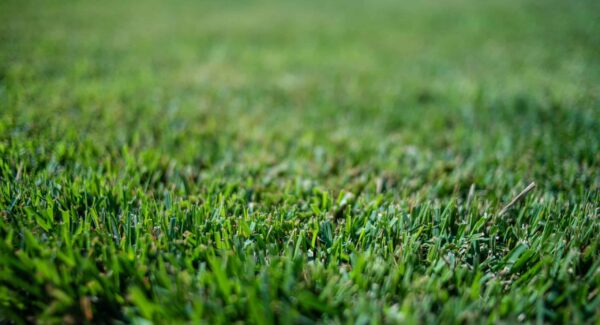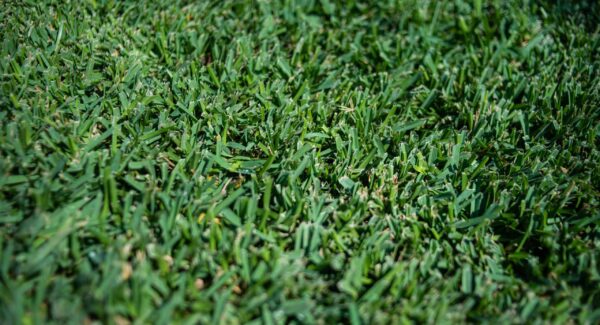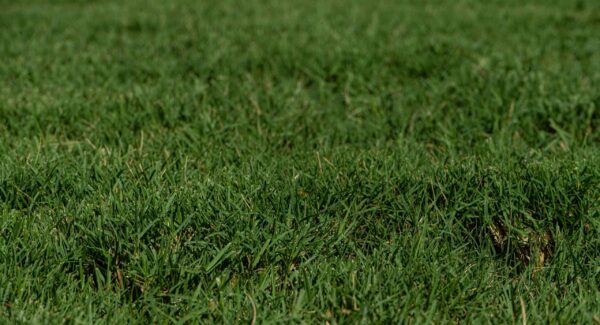How to Get Rid of Moles in Your Lawn: A Complete Guide
Your perfect lawn took months of care. You watered, fertilized, and mowed with precision. Then, one morning, you step outside and see them—unsightly mounds of dirt scattered across your once-pristine grass. Moles have moved in, and they’re renovating without permission.
Moles destroy lawns and gardens with their constant tunneling. Their underground highways create uneven surfaces that damage mower blades and cause tripping hazards. The frustration feels real when these subterranean pests take over your outdoor space.
You need solutions that work, not myths and temporary fixes. This guide will walk you through practical strategies to reclaim your lawn from these persistent diggers.
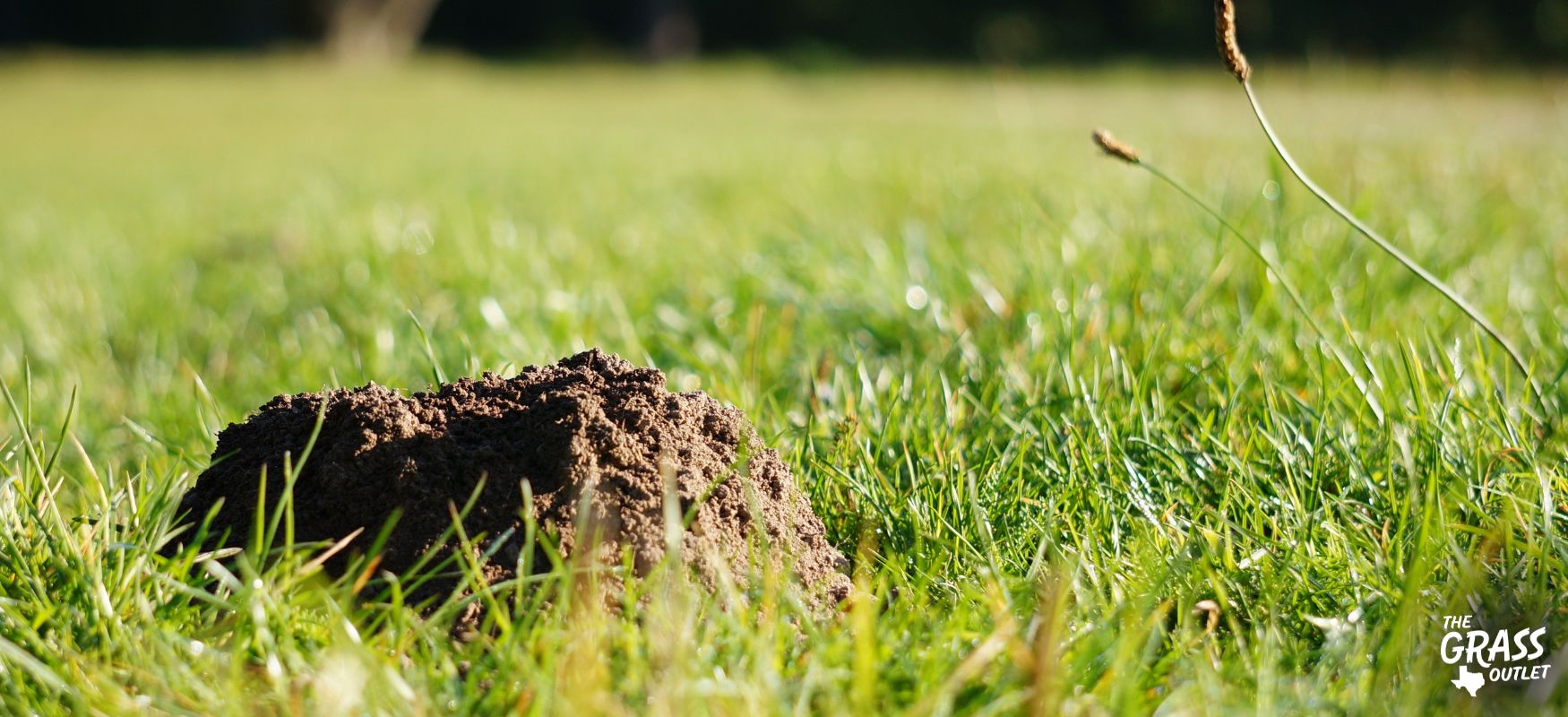
Understanding Moles: Behavior and Habitat
Moles measure about 6-8 inches long and have velvety fur, usually gray to brown. Their most distinctive features include oversized front paws with prominent claws designed for digging. These creatures spend almost their entire lives underground in complex tunnel systems.
Your lawn becomes attractive to moles when it offers abundant food sources. Moles consume earthworms, grubs, and insects—up to their body weight daily. Loose, moist soil creates ideal digging conditions, which explains why well-watered lawns often face mole issues.
Signs Your Lawn Has Moles
Mole detection starts with recognizing their calling cards. These telltale signs include:
- Molehills: Cone-shaped mounds of loose soil pushed up from deep tunnels
- Raised ridges: Lines of raised soil showing the paths of feeding tunnels just below the surface
- Dying grass: Patches where tunneling has separated grass roots from the soil
Most mole activity occurs in spring and fall when soil moisture levels remain high. The damage becomes more noticeable after rain when tunneling activity increases.
Identifying Mole Damage vs. Other Pests
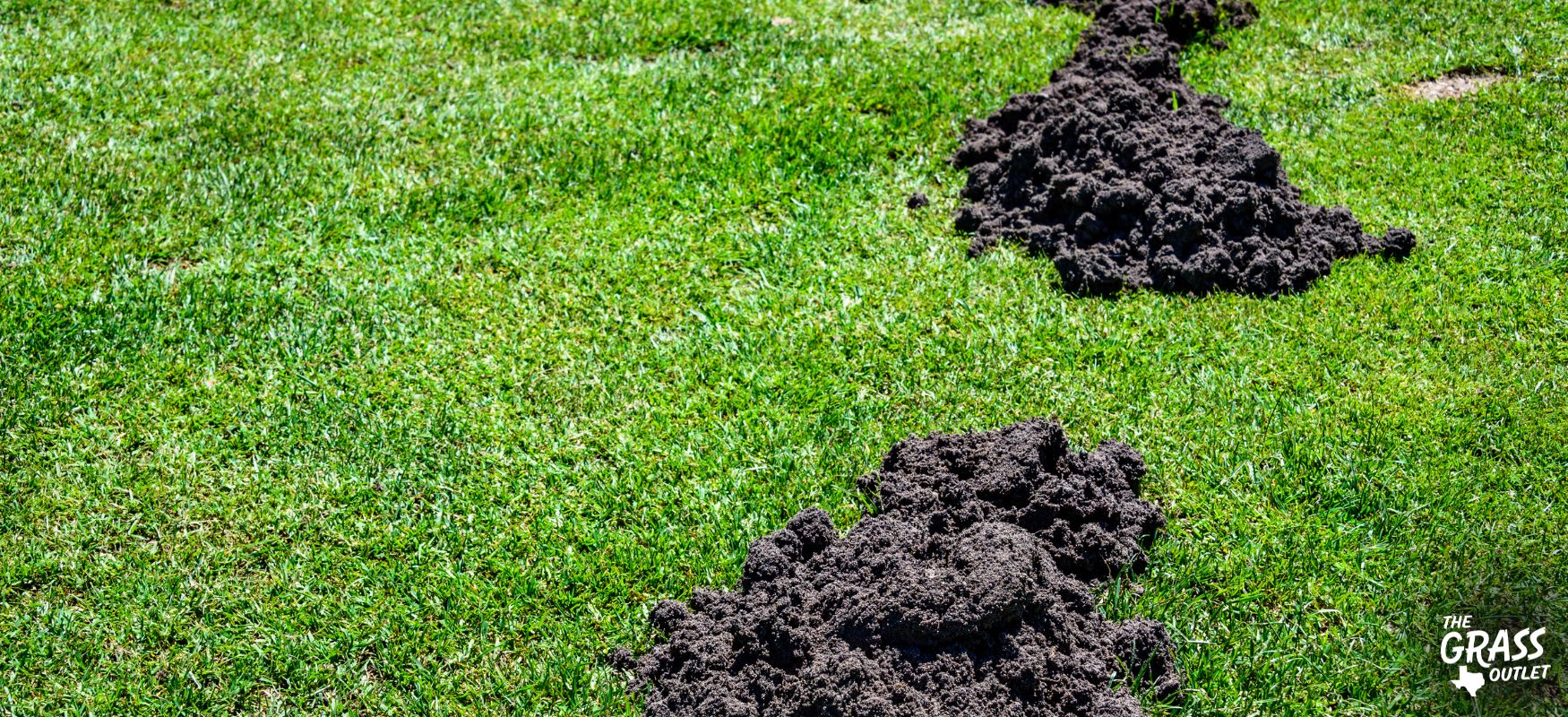
People often mistake mole damage for other lawn problems. Voles and gophers create similar issues, but differences exist in the patterns they leave behind.
Moles create distinctive volcano-shaped mounds without visible entrance holes. The soil appears finely sifted. Tunnels form raised ridges that snake across your lawn in irregular patterns.
Gophers leave larger, horseshoe-shaped mounds with visible holes, while voles create surface runways through your grass rather than raised tunnels. These differences matter because effective control methods vary by pest.
Your lawn damage appears as unsightly mounds and ridges rather than consumed plants. Moles don’t eat your grass—they damage roots while hunting for insects. Garden damage often appears as wilted plants whose roots have been disturbed by tunneling activity.
Effective Methods to Remove Moles
1. Trapping
Trapping remains the most reliable method for eliminating moles from your property. Various trap styles exist, but three main types dominate the market:
- Harpoon traps: These devices stand above the ground and drive spikes into moles when triggered
- Scissor traps: These sit within the tunnel and close around moles when activated
- Choker-loop traps: These encircle moles within their tunnels when triggered
Successful trapping requires proper placement. You must find active tunnels—not just random mounds. Press down on raised ridges throughout your yard. Check the area the next day. Repaired ridges (raised again) indicate active tunnels perfect for trap placement.
The benefits of trapping include immediate results and confirmation of capture. Drawbacks involve the hands-on nature of trap setting and removal, plus the need for proper disposal afterward.
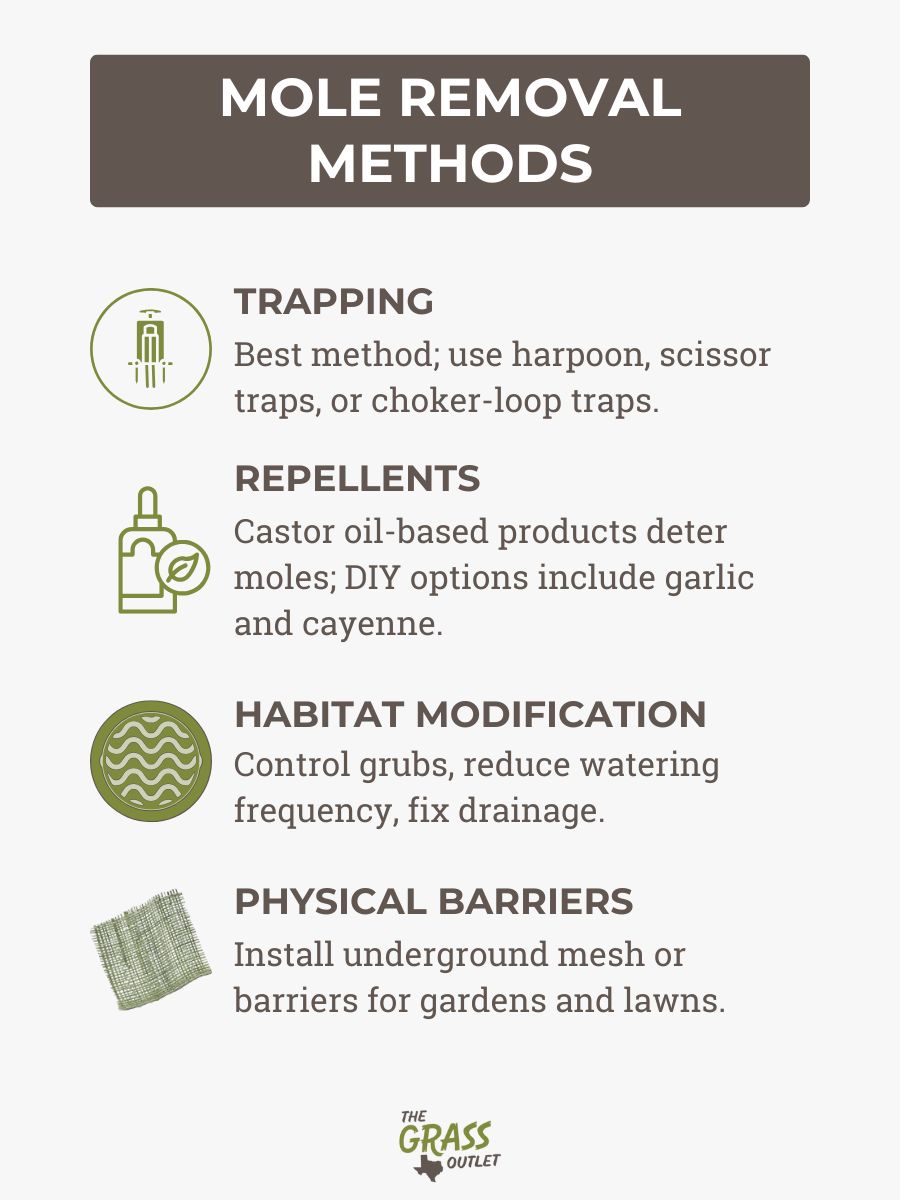
2. Repellents
Commercial repellents offer a less hands-on approach. Castor oil-based products lead the market with formulations designed for mole control. These liquids or granules make the soil less hospitable, creating an unpleasant environment.
Application methods vary by product formulation:
- Liquid repellents require dilution and coverage over the entire yard
- Granular types need spreading followed by thorough watering
Many homeowners prefer natural options. Castor oil mixtures can be made at home. A simple recipe combines 6 ounces of castor oil with two tablespoons of dish soap mixed into 1 gallon of water. This mixture gets sprayed over affected areas and watered in thoroughly.
Other DIY repellents include garlic and cayenne pepper solutions. These strong-smelling substances irritate moles’ sensitive noses. Results vary widely with homemade treatments.
3. Habitat Modification
Moles move into areas with abundant food, so your approach should address this root cause. Grub control becomes crucial in this effort. Products containing beneficial nematodes or milky spores provide natural control without harsh chemicals.
Lawn moisture management plays a key role, too. Overwatered grass creates ideal conditions for earthworms and grubs that attract moles. Consider these changes:
Reduce irrigation frequency, but water deeply when you do.
Most homeowners make the mistake of watering their lawns too frequently with shallow application. This approach keeps the soil surface consistently moist—exactly what moles prefer. You should switch to watering only 1-2 times per week, applying enough water to penetrate 4-6 inches deep each time. This irrigation strategy encourages grass to develop deeper root systems, allowing the upper soil layers to dry out. Moles dislike hunting in dry surface soil and often move to more hospitable areas. Your grass becomes healthier with this watering pattern, making it more resilient to drought and mole damage.
Fix drainage issues that create consistently wet soil throughout your property.
Low spots that collect standing water after rain serve as perfect mole habitats. These areas maintain ideal moisture levels for earthworms and soil insects that moles consume. Identify depressions by checking your yard after heavy rainfall. Address minor low spots by gradually building them up with thin layers of loam topsoil mixed with compost. More significant drainage problems might require installing French drains or dry creek beds to direct water away from problem areas. Pay special attention to areas near downspouts where concentrated water flow creates perpetually damp conditions. Simple downspout extensions can redirect water further from your foundation and lawn.
Allow soil to dry between watering sessions.
You can test soil moisture by inserting a screwdriver into the ground—if it penetrates quickly, the soil contains adequate humidity. Wait until the top 2-3 inches feel dry before watering again. This cycling between moist and dry conditions stresses moles without harming your lawn. The earthworms and grubs moles feed on will move deeper during dry periods, forcing moles to work harder for their meals. Many moles will relocate rather than expend extra energy digging deeper tunnels. This strategy works particularly well during cooler seasons when grass requires less frequent irrigation.
A healthy lawn resists damage and recovers faster from mole activity. Regular fertilization, proper mowing, and core aeration strengthen grass root systems. Strong roots reconnect with soil more quickly after tunneling disrupts them.
4. Physical Barriers
Some yard areas deserve extra protection. Underground barriers, which require installation effort but provide lasting results, can benefit gardens, flower beds, and small lawn sections.
Materials that work well include:
- Hardware cloth with 1/4-inch mesh
- Commercial mole barrier fabric
- L-shaped footer barriers extending 10 inches deep and 10 inches outward
Installation involves digging a trench around the protected area. The barrier material gets placed in this trench with the horizontal portion facing outward (away from what you protect). This design prevents moles from tunneling under the barrier.
Methods to Avoid
Myths That Don’t Work
The internet overflows with questionable mole control advice. These common myths waste time and money:
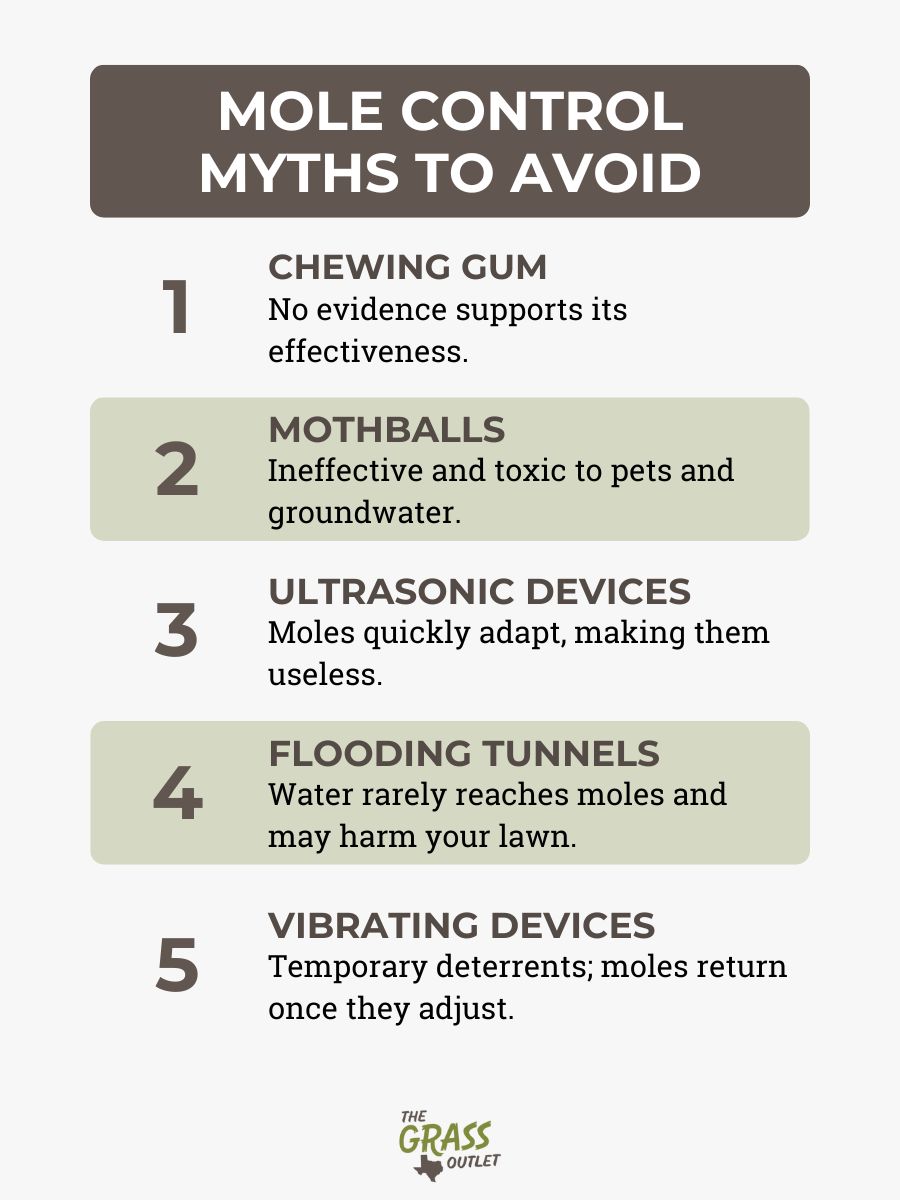
- Chewing gum: Stories claim moles eat gum but cannot digest it. No scientific evidence supports this method.
- Mothballs: These toxic products don’t penetrate tunnels deeply enough. They also pose risks to pets, children, and groundwater.
- Ultrasonic devices: Despite marketing claims, research hasn’t demonstrated effectiveness. Moles quickly adapt to these sounds.
- Flooding tunnels: Water rarely reaches moles in their deeper tunnels. This approach wastes water and often damages lawns further.
Vibrating devices and toy pinwheels appear in many folk remedies. These create disturbances that may temporarily drive moles away. However, they typically return once they adjust to the vibrations.
Preventing Future Mole Infestations
Prevention saves time and frustration compared to reactive control measures. Your strategy should include regular lawn maintenance practices that discourage mole activity.
Proper lawn care makes conditions less attractive to moles. Aeration and dethatching improve soil structure in ways that make tunneling more difficult. Core aeration pulls small soil plugs that, when broken down, create firmer soil structure.
Early detection gives you advantages in mole control. Regular lawn inspections help you spot initial signs before extensive tunnel systems develop. Walk your property weekly during spring and fall (peak mole seasons) to check for new activity.
Natural predator encouragement provides additional help. When moles surface, owls and hawks prey on them. Installing owl boxes or raptor perches creates a habitat for these beneficial hunters.
When to Seek Professional Help
Some situations exceed DIY capabilities. Professional pest control services bring expertise and specialized tools to complex mole problems.
Your mole situation might need professional intervention if:
- Multiple capture attempts fail
- Damage continues despite repellent applications
- Property size makes self-treatment impractical
- Adjacent properties have ongoing mole issues
Professional services offer several advantages. Technicians accurately identify tunnel systems. They use commercial-grade products unavailable to homeowners. Most importantly, they provide systematic follow-up to ensure complete resolution.
The cost depends on property size and infestation severity. Many companies offer guarantees that justify this investment compared to repeated DIY attempts.
Practical Steps for Immediate Action
Map the damage
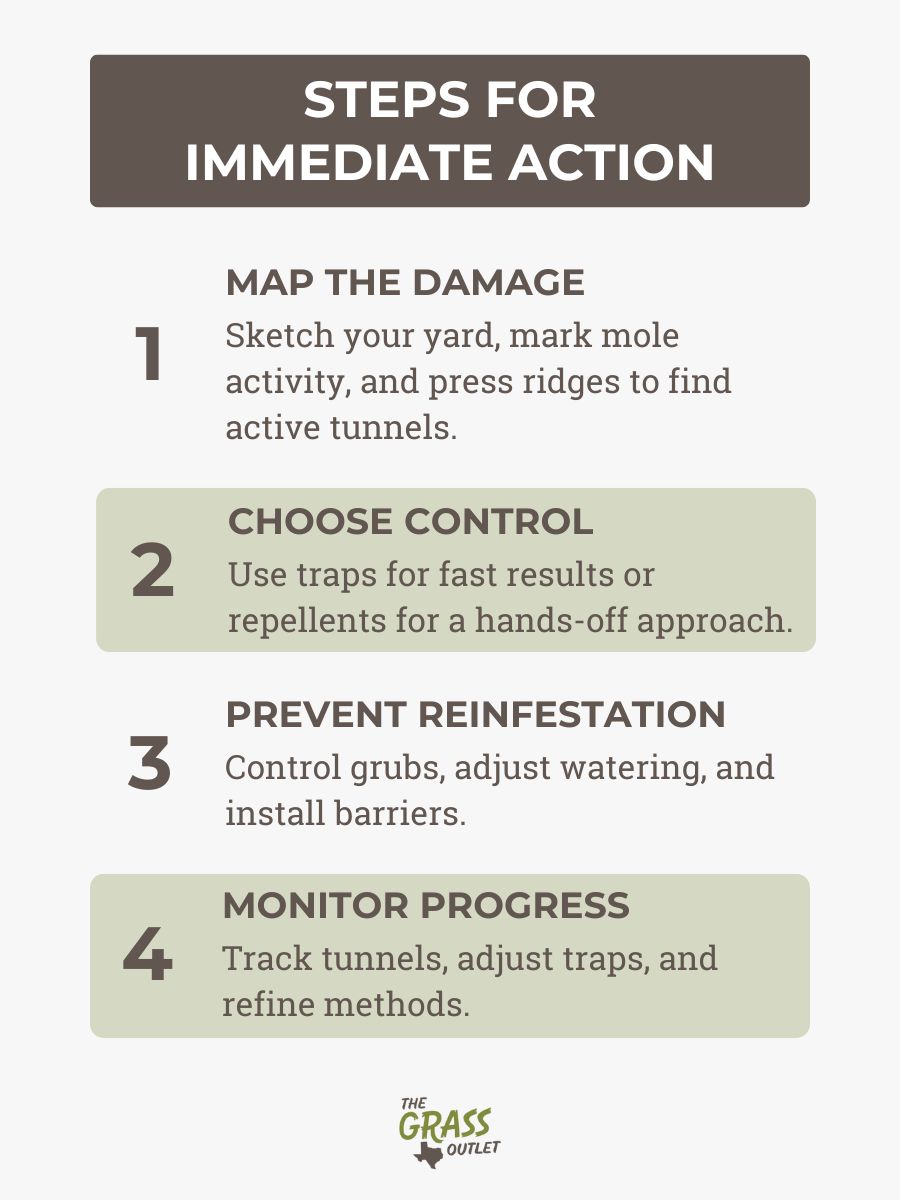
Check these locations 24 hours later. Tunnels that have been raised again indicate current mole activity. Abandoned tunnels stay flattened. This mapping process reveals the scope of your infestation and pinpoints exactly where to focus your control efforts.
Primary control method
Select your primary control method based on your personal preferences and the severity of your mole problem. Trapping offers the most definitive solution but requires direct handling of the captured moles. If this makes you uncomfortable, repellents provide a hands-off alternative with less specific results. Start with castor oil repellents applied to the entire lawn for small infestations. More significant or persistent problems usually require appropriately placed traps. Your soil type also influences this choice. Sandy soils allow easier trap placement, while clay soils might benefit from repellents that penetrate deeply. Base your decision on the practical aspects and your willingness to deal directly with the captured animals.
Implement secondary prevention measures
Grub control products applied according to package directions reduce a primary food source. Apply milky spores or beneficial nematodes for natural grub management without harsh chemicals. Adjust your irrigation schedule to allow the soil surface to dry between waterings.
This practice discourages earthworms from near the surface where moles can easily detect them. Create physical barriers around particularly valuable garden areas by burying hardware cloth at least 10 inches deep. These simultaneous approaches attack the problem from multiple angles, increasing your chances of success while preventing re-infestation.
Monitor results daily
You can evaluate your progress and make necessary strategy adjustments. Each morning, walk your property to check for new mounds or raised tunnels. Mark these on your property map using a different color to track new versus existing damage. Reassess trap locations if you fail to make captures within 48 hours. Traps in inactive tunnels waste time and effort. For repellent approaches, note areas where tunneling continues despite application. These spots might need stronger concentration or different products. Keep a simple journal logging your actions and results. This record proves invaluable for identifying which methods work best in your specific soil and climate conditions, especially for dealing with seasonal mole returns.
Your response timing matters significantly. Fresh tunnels indicate recent activity and make ideal locations for control measures. Addressing problems within the first week of noticing signs dramatically increases success rates.
The Lawn Recovery Process
Once moles leave, restoration begins. Your lawn needs help recovering from the damage. These steps support rapid healing:
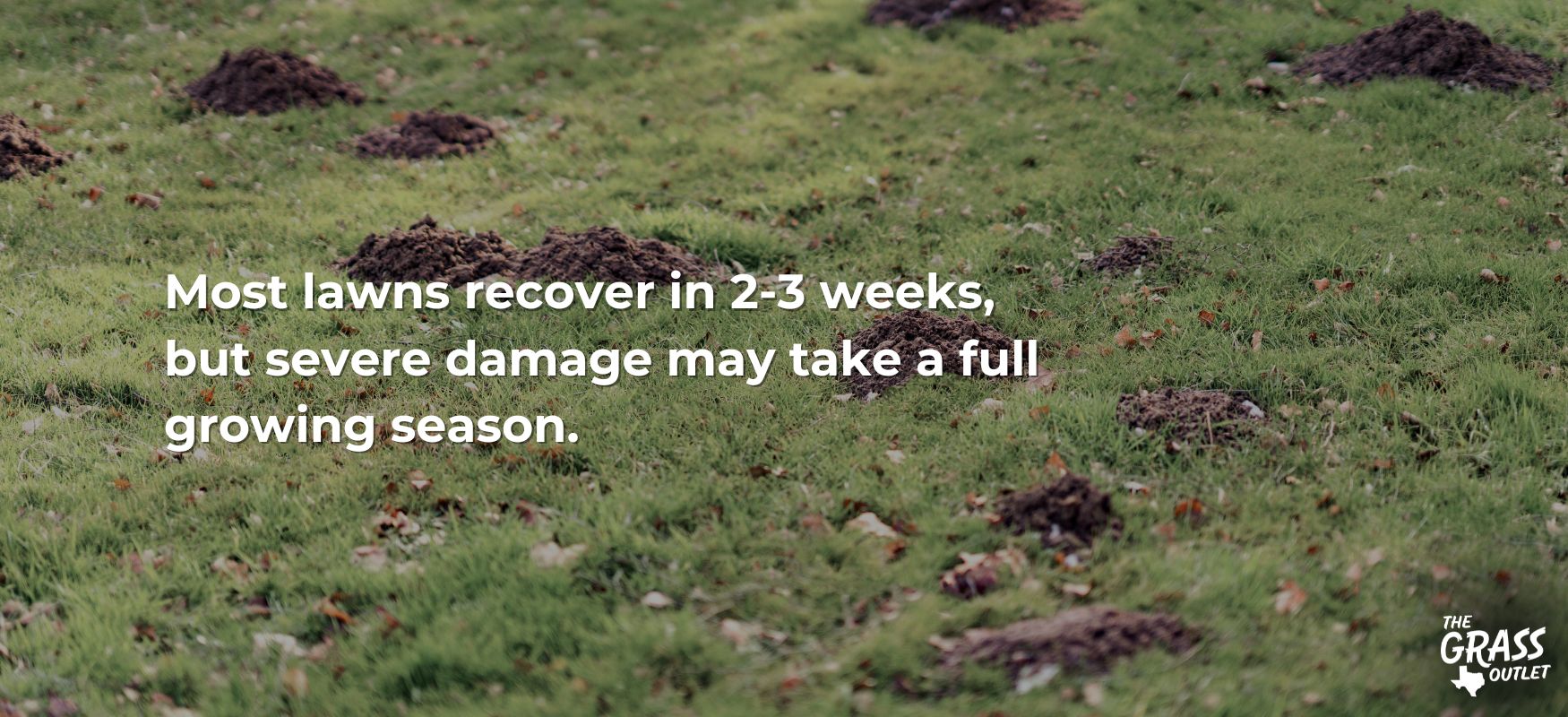
Flatten raised tunnels as your first recovery step. The tunnels left behind create uneven surfaces, affecting appearance and lawn health. You can press down smaller tunnels with your feet by walking methodically across affected areas. For larger sections, a lawn roller provides more consistent results. The weight compacts the soil back into place and helps reconnect grass roots with the soil beneath. This step works best after light rain or irrigation when soil remains slightly moist but not soggy.
Resod bare patches where tunnel damage caused the grass to die off. Mole activity often separates grass roots from the soil, leading to dead patches throughout your lawn. Start by loosening the top inch of soil with a rake to create a good root bed. Choose a grass variety available in smaller quantities that matches your lawn for a consistent appearance. Plant the grass pieces, then walk across the pieces to ensure good soil contact.
Provide adequate water to promote root development without creating conditions that attract more moles. New grass requires consistent moisture to establish properly. Water deeply once daily for ten to fourteen days, keeping the soil consistently moist. Gradually reduce watering frequency while increasing duration over the following weeks. This approach promotes deeper root growth while avoiding constant soil saturation that attracts earthworms and grubs. Monitor weather conditions and adjust accordingly – hot, dry days require more frequent watering, while cool or rainy periods need less supplemental irrigation.
With proper recovery care, most lawns show significant improvement within 2-3 weeks. Areas with extensive damage might require an entire growing season to recover completely.
Our Recommendations
At The Grass Outlet, we understand mole control requires a comprehensive approach. Our customers find the most tremendous success with combined strategies rather than single methods.
For most home lawns, we recommend:
- Starting with adequately placed traps in active tunnels
- Following up with castor oil repellents applied to the entire lawn
- Implementing grub control measures seasonally
- Adjusting irrigation schedules to prevent soil saturation
These steps create multiple barriers to mole activity while addressing underlying attractions. The integrated approach yields more permanent results than any single method alone.
How The Grass Outlet Can Help
Our knowledgeable staff understands the local growing conditions. We can recommend the best grass varieties that thrive in your area while requiring less water, creating naturally drier soil conditions that are less attractive to moles.
Mole problems often indicate underlying lawn health issues. The Grass Outlet helps address these root causes through proper grass selection and care advice. A thick, healthy lawn looks beautiful and resists and recovers better from mole activity.
Don’t let moles undermine your lawn investment. Visit The Grass Outlet today to discuss your lawn concerns and discover the perfect sod options for creating a resilient, beautiful yard that stands up better to pests of all kinds.
